Tuccia, was an ancient Roman Vestal Virgin. Its supposed by her nomen that she belonged to the Gens Tuccia. She is known for an incident in which her chastity was questioned by a spurious accusation. The punishment for vestal virgins who lost their chastity were if they could not prove their innocence - were to be sentenced to immurment. In Tuccia's case, to save her reputation and life she utilized a flat perforated basket to carry water, from the Tiber to the Temple of Vesta without the water falling to the ground through the sieve.
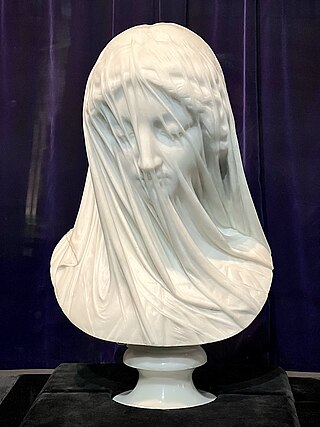
The Veiled Virgin is a Carrara marble statue carved in Rome by Italian sculptor Giovanni Strazza (1818–1875) depicting the bust of a veiled Virgin Mary. The exact date of the statue's completion is unknown, but it was probably in the early 1850s. The veil gives the appearance of being translucent, but is carved of marble. The technique is similar to Giuseppe Sanmartino's 1753 statue Veiled Christ in the Cappella Sansevero in Naples.
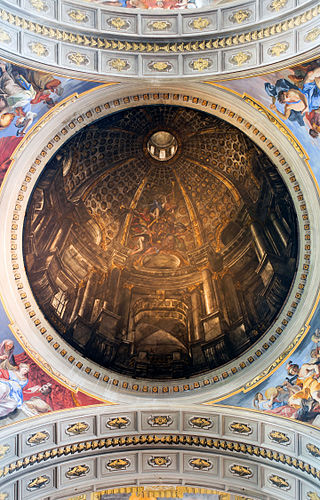
Illusionistic ceiling painting, which includes the techniques of perspective di sotto in sù and quadratura, is the tradition in Renaissance, Baroque and Rococo art in which trompe-l'œil, perspective tools such as foreshortening, and other spatial effects are used to create the illusion of three-dimensional space on an otherwise two-dimensional or mostly flat ceiling surface above the viewer. It is frequently used to create the illusion of an open sky, such as with the oculus in Andrea Mantegna's Camera degli Sposi, or the illusion of an architectural space such as the cupola, one of Andrea Pozzo's frescoes in Sant'Ignazio, Rome. Illusionistic ceiling painting belongs to the general class of illusionism in art, designed to create accurate representations of reality.

The Palazzo Barberini is a 17th-century palace in Rome, facing the Piazza Barberini in Rione Trevi. Today, it houses the Galleria Nazionale d'Arte Antica, the main national collection of older paintings in Rome.

Francesco Mochi was an Italian early-Baroque sculptor active mostly in Rome, Piacenza and Orvieto. His dramatic early works in Orvieto are now often regarded as the first truly Baroque sculptures.

Antonio Corradini was an Italian Rococo sculptor from Venice. He is best known for his illusory veiled depictions of the human body, where the contours of the face and body beneath the veil are discernible.

Raffaele Monti was an Italian sculptor, author and poet.
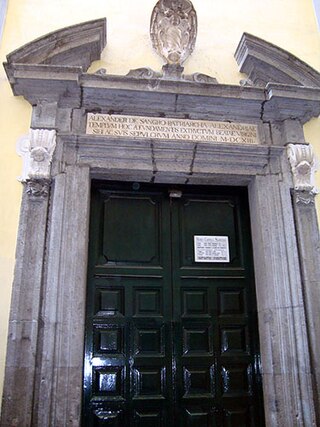
The Cappella Sansevero is a chapel located on Via Francesco de Sanctis 19, just northwest of the church of San Domenico Maggiore, in the historic center of Naples, Italy. The chapel is more properly named the Chapel of Santa Maria della Pietà. It contains works of Rococo art by some of the leading Italian artists of the 18th century.

The Rape of Proserpina, more accurately translated as the Abduction of Proserpina, is a large Baroque marble group sculpture by Italian artist Gian Lorenzo Bernini, executed between 1621 and 1622, when Bernini's career was in its early stage. The group, finished when Bernini was just 23 years old, depicts the abduction of Proserpina, who is seized and taken to the underworld by the god Pluto. It features Pluto holding Proserpina aloft, and a Cerberus to symbolize the border into the underworld that Pluto carries Proserpina into.

Andrea Camassei was an Italian Baroque painter and engraver mainly active in Rome under the patronage of the Barberini.

The Veiled Rebecca or The Veiled Rebekah is a 19th century sculpture carved out of marble in Italian neoclassical style by the sculptor Giovanni Maria Benzoni.The sculpture is also referred as The Veiled Lady in several records. It depicts a biblical figure of Rebecca placed on a marble pedestal.

Raimondo di Sangro, Prince of Sansevero was an Italian nobleman, inventor, soldier, writer, scientist, alchemist and freemason best remembered for his reconstruction of the Sansevero Chapel in Naples.
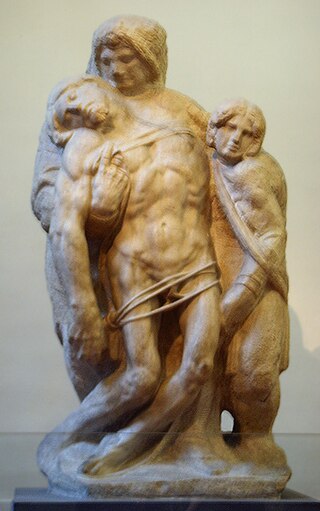
The Palestrina Pietà is a marble sculpture of the Italian Renaissance, dating from c. 1555 and now in the Galleria dell'Accademia, Florence. It was formerly attributed to Michelangelo, but now it is mostly considered to have been completed by someone else, such as Niccolò Menghini or Gian Lorenzo Bernini. According to the Galleria dell'Accademia, the sculpture's "attribution to the master is still somehow controversial".

Giuseppe Sanmartino or Giuseppe Sammartino was an Italian sculptor during the Rococo period.
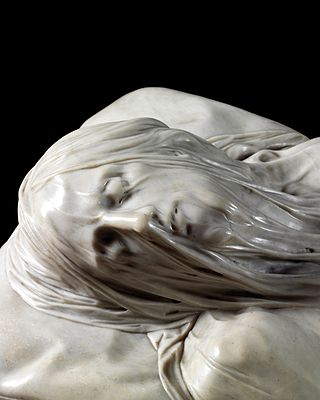
Veiled Christ is a carved marble sculpture completed in 1753 by the Neapolitan artist Giuseppe Sanmartino. It is formed from a single block of white marble, and was commissioned by Raimondo di Sangro, a prince of Sansevero, as the centerpiece of the Cappella Sansevero, in Naples, Italy.
The Vestal Claudia Towing the Ship Bearing the Statue of Cybele is a painting by the Italian Renaissance painter Benvenuto Tisi in the Galleria Nazionale d'Arte Antica at Palazzo Barberini in Rome, Italy.

The Veiled Nun is a marble bust depicting a female figure, sculpted by an unidentified Italian workshop c. 1863. Despite its name, the woman depicted is not a nun.

Modesty or Chastity or Veiled Truth by Antonio Corradini is a sculpture completed in 1752 during the Rococo period. Corradini was commissioned by Raimondo di Sangro to sculpt a memorial for his mother in the Cappella Sansevero in Naples, where the marble sculpture still remains.
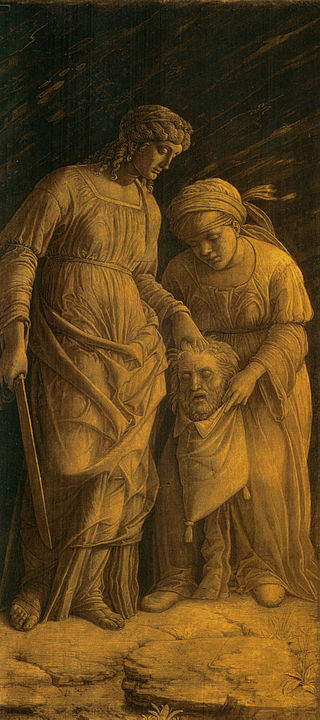
Exemplary Women of Antiquity is a set of paintings produced between 1495 and 1500 by Andrea Mantegna. They show the Carthaginian noblewoman Sophonisba poisoning herself to avoid being paraded in a Roman triumph, the Roman Vestal Virgin Tuccia proving her chastity by carrying water in a sieve, Judith with the head of Holofernes and Dido holding Sychaeus's funeral urn. Infrared reflectography has uncovered a signature on the back of Judith reading And.a Mantegnia. P[inxit].. Sophonisba and Tuccia are egg-tempera on poplar panel, whilst Judith and Dido are glue-tempera on linen canvas.

The Veiled Vestal is an 1847 sculpture by Rafaelle Monti. It was commissioned by William Cavendish, 6th Duke of Devonshire during an 1846 trip to Naples. It is a representation of a Vestal Virgin, the priestesses of the Ancient Roman goddess Vesta. The subject was popular at this time due to the then recent discovery of the House of the Vestals in Pompeii. The depiction of translucent fabrics was popular at the time and Monti was requested to use the technique in this sculpture. Monti completed the sculpture in April 1847 and it was afterwards displayed at Cavendish's West London Chiswick House.






















